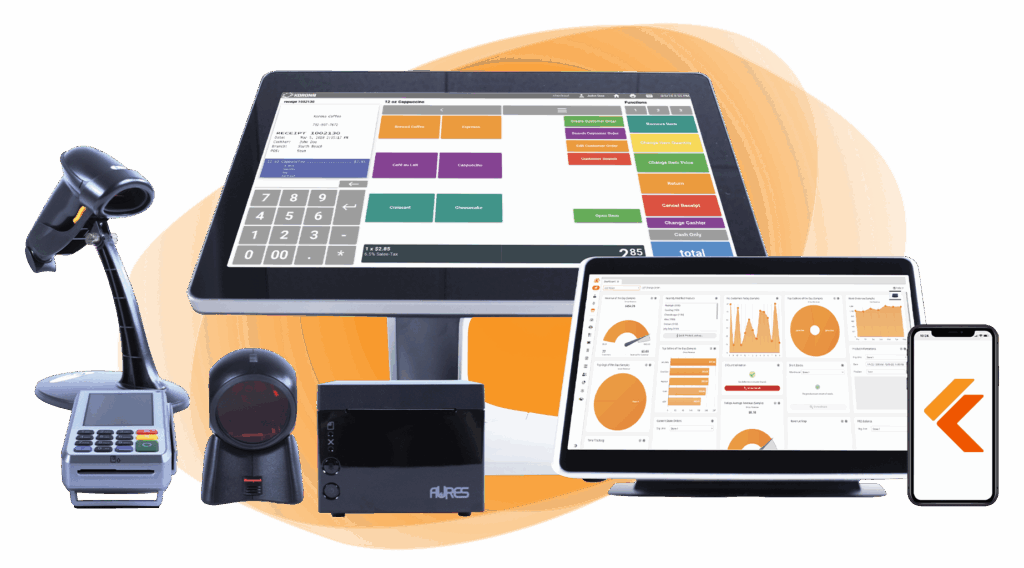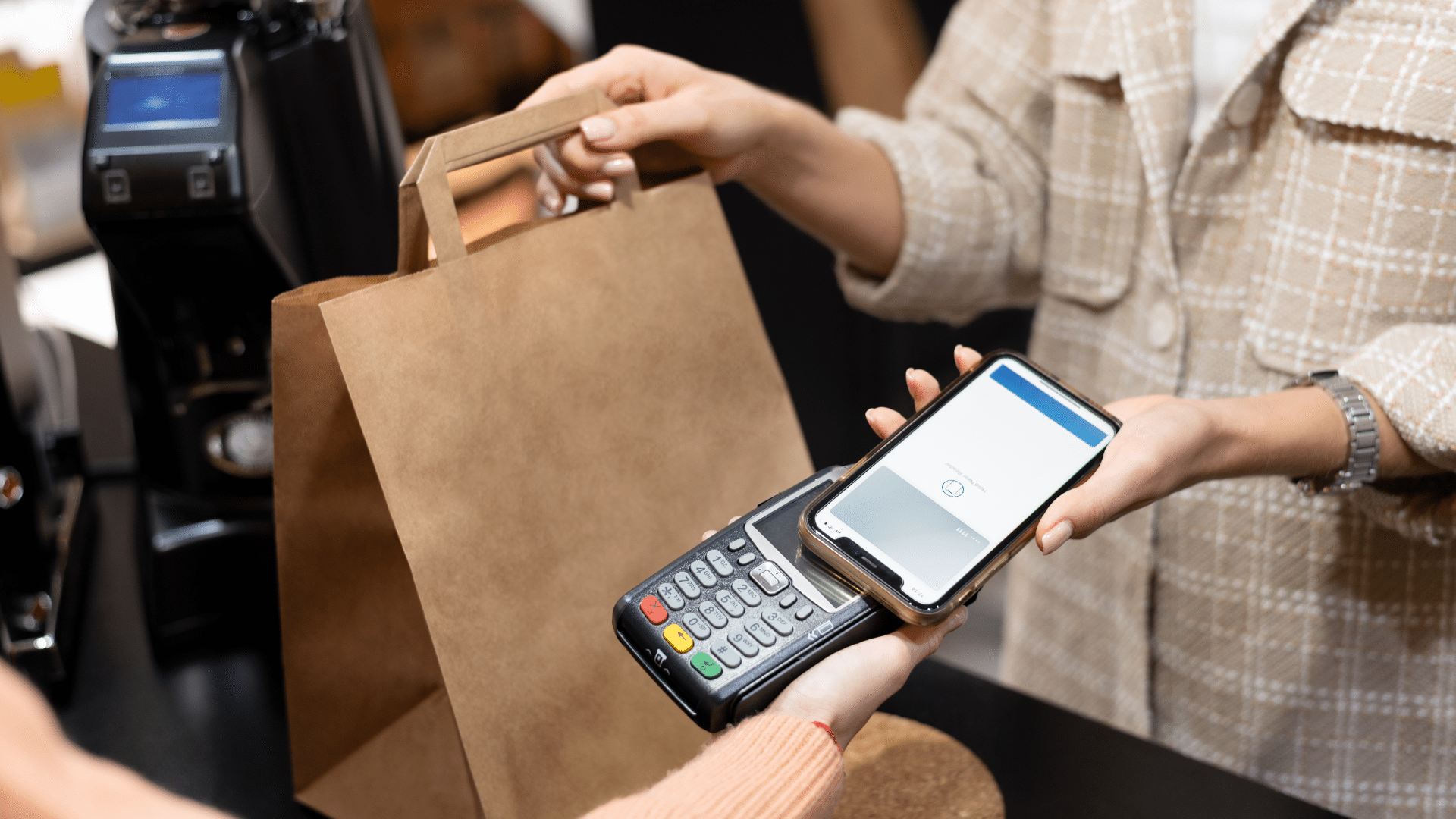Key Takeaways
- Payment methods: Customers can pay with cash, credit/debit cards, mobile wallets (Apple Pay, Google Pay), or buy-now-pay-later services.
- POS systems: These process payments in-store and often integrate with inventory, customer data, and sales tracking.
- Payment processors: Companies (like Stripe, Square, Worldpay) that handle the transfer of funds between the customer’s bank and the retailer’s bank.
- Merchant accounts: A special type of bank account that businesses need to accept card payments.
- Transaction fees: Retailers pay fees (usually a percentage + fixed amount per transaction) for each card or digital payment.
Retail payment processing is a constant pain point for retail business owners. Difficulties arise from not understanding the complex fees and pricing models, picking the right payment methods for their business, navigating security compliance, and choosing a payment processor that fits a business’s needs.
By the end of this guide, you will be to:
- Understand what retail payment processing entails
- Know how it works, the key fees, and pricing models
- Grasp popular payment methods
- Pick between integrated vs. non-integrated terminals
- Choose the best payment processor for your business needs
What Is a Retail Payment Processing?
Retail payment processing is the system that enables merchants to accept and manage customer payments securely.
It involves hardware (like card readers), software (such as retail POS systems), and relationships with banks and payment processors to handle transactions like credit card, debit card, or mobile wallet payments.
In a nutshell
The process involves authorizing the payment, verifying the funds, checking for fraud, and transferring the money from the customer’s bank account to the merchant’s account. For example, when a customer buys a smartphone, the POS system processes the card payment. Ultimately, it’s the behind-the-scenes technology and relationships that make modern retail sales possible.
The Importance of Retail Payment Processing
Retail payment processing is about building customer trust, increasing efficiency, and delivering a secure and seamless transaction experience. Here are some of its benefits:
Customer Convenience and Loyalty: A reliable payment system allows shoppers to pay quickly with cards, contactless methods, or mobile wallets.
Revenue Protection: Effective fraud detection and chargeback management enable businesses to prevent losses, resolve disputes efficiently, and safeguard their profit margins.
Stable Cash Flow: Timely settlement of funds ensures predictable cash flow, enabling retailers to manage inventory, payroll, and expenses without delays.
Trust and Security: PCI-compliant and secure systems protect sensitive customer data, strengthening brand reputation and building long-term trust.
Operational Efficiency: Integration with point of sale systems automates reconciliation and reporting, reducing manual tasks and allowing staff to focus on customer service.
Scalability and Growth: Modern platforms support multiple currencies, online and in-store channels, and new payment methods.
Data-Driven Insights: Transaction data provides valuable information on customer behavior, peak shopping times, and product performance for smarter decision-making.
Enhanced Customer Experience: Easy refunds, digital receipts, and loyalty program integration create a positive experience that keeps shoppers coming back.
Future Readiness: Investing in advanced payment technology prepares retailers for evolving consumer expectations and regulatory changes.
How Does Retail Payment Processing Work?
Retail payment processing is the behind-the-scenes magic that makes buying things with your credit card or debit card at your favorite stores possible (and, typically, remarkably easy). Here is how it works:
1. The Customer’s Card: They hand over a credit or debit card to the cashier, swipe, dip, or tap their card, pay with a smartphone or smartwatch, or input their card information online.
2. Data encryption: When you insert your card, the machine encrypts your information. Encryption is like putting your card details in a secret code that only banks and payment processors can understand.
3. Authorization request: The card reader sends an authorization request to your bank or credit card company. This request includes the purchase amount and your card details. The bank or credit card company checks to see if you have sufficient funds in your account or if your credit limit is enough for the purchase.
4. Bank approval: If everything is in order, your bank approves the transaction. They confirm that you have the funds or credit to make the purchase.
5. Transaction approval: Once your bank gives the green light, the payment processor (a middleman company that helps facilitate transactions) gets involved. They relay the approval back to the store’s payment system.
6. Receipt and payment: Your receipt prints out, and you get your items. At the same time, the payment processor starts moving the money from your bank to the store’s bank. This is the actual transfer of funds.
7. Settlement: At the end of the day, the payment processor gathers up all the approved transactions and sends them to the store’s bank. This is like settling the bill for all the day’s purchases.
8. Store gets paid: The store’s bank receives the money from the payment processor and adds it to its account. The store has now been paid for your purchase.
9. Your bank updates: On your side, your bank updates your account to reflect the purchase. Using a credit card will show as a pending transaction until it’s officially posted to your account, usually within a day or two.
10. Monthly statement: At the end of the billing cycle, you receive your credit card statement, which lists all your purchases during that period. You’re responsible for paying the credit card company back for your purchases.
Here are the terms that you need to understand when learning about retail payment processing:
- Merchant account: A merchant account is a bank account specifically designed for businesses to accept credit and debit card payments.
- Issuing bank: This is the shopper’s bank which distributes the funds for any authorized purchase.
- Payment gateway: A payment gateway is a service that allows merchants to accept payments from customers online.
- Payment processor: A payment processor differs from a gateway. It is a company that facilitates the transfer of funds between merchants and banks.
Types of Retail Payment Methods?
When it comes to retail, customers now expect more than just the traditional “cash or card” question. Payment methods can broadly be divided into primary payment methods (the most widely used and expected forms) and alternative payment methods (growing in popularity and often linked to new technologies).
Primary Payment Methods
These are the go-to options that most people and retailers rely on day-to-day. They’re straightforward, widely accepted.
- Cash Transactions: Despite a decline in use, cash remains a fundamental payment method, especially for small, immediate purchases. Its key advantages are anonymity and the absence of transaction fees, making it a simple and direct way to pay. However, it presents security risks and is not practical for large purchases due to the difficulty and danger of carrying significant amounts.
- Debit Card Payments: A highly popular method for everyday transactions, debit cards offer the convenience of a card while directly drawing funds from a customer’s bank account. This provides a secure, digital record of every transaction and helps customers manage their spending by limiting them to their available funds, preventing debt.
- Credit Card Payments: Widely used for both online and in-store purchases, credit cards offer flexibility by allowing customers to make purchases on credit. This is particularly useful for high-value transactions or for managing cash flow. They come with robust security features and often include rewards programs or points, making them a very attractive option for many consumers.
Find out how much you’re spending.
Alternative Payment Methods
These methods are often driven by technological advancements, offering different levels of convenience, speed, and security.
- Mobile Wallet Payments: This payment method has grown rapidly and is revolutionizing how people pay. Services like Apple Pay and Google Pay allow users to store card information on their smartphones.
- RFID Self-Checkout: This is an emerging payment method that uses RFID technology to streamline the checkout process. Instead of scanning each item individually, the system automatically reads tags on all products, calculating the total and deducting the amount from a linked account. It’s incredibly fast and convenient, particularly for retailers with a high volume of small purchases, though it’s not yet widely adopted.
- Checks: Although their use has declined significantly, checks remain a viable payment method in certain sectors, particularly for business-to-business transactions or bill payments. They provide a physical record and a clear audit trail, but they are slow to process and carry a higher risk of fraud compared to electronic payments.
- Bank Transfers (ACH/Wire Transfers): These are direct electronic transfers of funds from one bank account to another. They are widely used for large-value transactions, bill payments, and subscription services, especially in B2B contexts. They are highly secure but can be slow and require the sender to have the recipient’s bank details, making them less suitable for traditional retail settings.
- Cryptocurrency: Digital currencies like Bitcoin and Ethereum are emerging as alternative payment methods. They offer decentralized transactions, which means they are not controlled by a central bank or government. While they offer a high degree of anonymity and low transaction fees for international payments, their volatility and the lack of widespread acceptance limit their use in mainstream retail for now.
- Buy Now, Pay Later (BNPL): Services like Klarna and Afterpay allow customers to split their purchases into several interest-free installments. This method has gained popularity, particularly for online shopping and high-value items.
- Gift Cards: A popular alternative for both giving and receiving, gift cards are a form of prepaid stored value. They are an easy way for customers to pay without using cash or a credit card and are often used to attract new customers or as a way to return store credit.
Retail Payment Processing Fees and Rates
When setting up payment processing, retailers must carefully consider the various fees and rates they will incur. Awareness of these costs allows retailers to accurately forecast their transaction costs and minimize fees where possible. Below are the main fees to understand:
- Interchange Fees: Paid to the customer’s bank each time a card is used. Rates vary by card type (debit, credit, rewards) and transaction method (swipe, chip, online).
- Assessment Fees: Charged by credit card networks like Visa or Mastercard. These are fixed, non-negotiable costs for using their networks.
- Processor Markup: The payment processor adds its fee on top of interchange and assessment costs. This is often where businesses can negotiate better rates.
- Flat Fees: Fixed charges per transaction, such as $0.10–$0.30 per sale, depending on the processor.
- Monthly Fees: Ongoing charges for account maintenance, statements, or access to the processor’s system.
- Equipment or POS Fees: Costs for renting or purchasing card readers, terminals, or full POS systems.
- Chargeback Fees: Penalties for disputed transactions, usually around $15–$25 per case.
- Incidental Fees: Extra costs like PCI compliance, early termination, or batch processing.
Pricing Models For Retail Payment Processing
The three main pricing models for retail payment processing are interchange-plus, tiered, and flat-rate:
Interchange-plus pricing
Interchange-plus pricing is the most common pricing model. It is also known as cost-plus pricing.
With interchange-plus pricing, the merchant pays the payment processor a percentage of the transaction amount (called the interchange fee) plus a markup fee. The payment processor sets the markup fee and can vary depending on the processor.
For example, let’s say a merchant processes a $100 transaction with a Visa credit card. The interchange fee for this transaction might be 2.5%, so the merchant would pay $2.50 to the card network. The payment processor might charge a markup fee of 0.5%, so the merchant would pay a total of $3 to the payment processor for this transaction.
Tiered pricing
Tiered pricing is a pricing model that divides transactions into different categories, each with a different pricing rate. The categories are typically based on the card type used, the transaction amount, or the merchant’s location.
For example, a tiered pricing plan might have three categories: qualified, mid-qualified, and non-qualified. Qualified transactions would have the lowest pricing rate, mid-qualified transactions would have an intermediate pricing rate, and non-qualified transactions would have the highest pricing rate.
This structure offers less transparency since retailers likely don’t know what determines the category into which transactions are placed.
Flat-rate pricing
Flat-rate pricing is a pricing model where the merchant pays a fixed percentage of the transaction amount to the payment processor, regardless of the type of card used or the transaction amount.
For example, a flat-rate pricing plan might charge 2.9% + $0.30 for every transaction. This means that the merchant would pay $2.90 plus $0.30 for every $100 transaction, regardless of the type of card used.
The best pricing model for a merchant will depend on their specific business:
- Merchants with high-volume, low-margin businesses may benefit from interchange-plus pricing, as they can negotiate lower markup fees with payment processors.
- Merchants with low-volume, high-margin businesses may benefit from tiered pricing, as they can pay lower rates for qualified transactions.
- Merchants with new or growing businesses may benefit from flat-rate pricing, as it can provide a more predictable cost structure.
Integrated vs. Non-integrated Payment Terminals
Integrated and non-integrated payment terminals are two different ways to process payments.
Integrated payment terminals
- The payment terminal is built into the point of sale system
- Allows for seamless transactions – cashier can switch between taking orders and accepting payments within the same system
- Transaction information is automatically captured and stored in the POS reporting
- Requires compatibility between the POS and payment processing capabilities
- Often comes bundled together as a complete POS hardware/software package

Build Your Own POS
Whether you run a retail store, café, or admissions booth, we have the point of sale hardware designed for your specific needs. Start building your ideal POS system now.
Non-integrated payment terminals
- The payment terminal is a completely separate device from the POS system
- Cashier must enter the amount to be charged manually into the terminal after ringing up in the POS
- Does not automatically capture transaction data for reporting
- Requires manual reconciliation between terminal and POS
- Allows flexibility to work with any processor or switch providers easily
Payment processors giving you trouble?
We won’t. KORONA POS is not a payment processor. That means we’ll always find the best payment provider for your business’s needs.
Key Differences between Integrated and Non-Integrated Payments
- With integrated terminals, transaction data flows between the POS and payment terminal. With non-integrated terminals, the POS and payment systems remain completely separate.
- Integrated systems allow faster checkout, while non-integrated terminals require cashiers to handle an additional device.
- Changing processors is more difficult with integrated systems because it likely means replacing the entire POS. Non-integrated terminals make it easy to switch payment processors.
- Upfront hardware costs are usually lower for non-integrated since the POS and payment terminals are separate. Integrated bundles may have higher initial costs.
For most modern retail operations, an integrated payment terminal is preferable because of seamless transactions and reporting. But budget-conscious retailers or merchants who want to easily change processors may opt for non-integrated terminals.
How to Choose the Best Retail Payment Processing System?
When you’re running a retail business, payments are at the heart of everything. Customers want to pay the way they prefer, and you want those payments to be secure, fast, and affordable. The tricky part is that not all payment processing systems are created equal.
Many POS systems today come “bundled” with their own payment processor—which can lock you in, limit your flexibility, and sometimes leave you paying higher fees than you should.
The smarter choice is to look for a POS that’s processing-agnostic.
1. Start With a POS System That’s Processing-Agnostic
A processing-agnostic POS means the software works with many payment processors instead of forcing you into one option. That’s rare these days, but incredibly valuable. Here’s why:
- Freedom to choose: You can shop around and negotiate better rates with multiple processors instead of being stuck with whatever the POS provider demands.
- High-risk industries: If you sell products like vape, CBD, or alcohol—where traditional processors sometimes say “no”—you can plug in a secondary processor that actually supports your business.
- Long-term flexibility: If you’re unhappy with fees, contract terms, or service from one provider, you can switch without changing your entire POS system.
Think of it like owning your car outright instead of leasing it—you’re free to take it to any mechanic, buy the gas you want, and customize it however you need.
2. Look at Processing Fees (but Don’t Stop There)
Once you’ve secured a processing-agnostic POS, you can compare processors side by side. Pay attention to:
- Transaction rates: Flat fee vs. percentage per transaction.
- Hidden costs: Monthly minimums, PCI compliance fees, batch fees, etc.
- Contract length: Avoid long-term lock-ins and hefty cancellation fees.
A common mistake is choosing the system with the “lowest advertised rate.” Sometimes that 2.6% fee balloons when you factor in all the add-ons.
3. Think About Your Customers’ Preferences
The best payment processing system is the one that makes checkout easiest for your customers. Ask yourself:
- Do they prefer tap-to-pay and mobile wallets?
- Do you sell high-ticket items where financing or Buy Now Pay Later would boost sales?
- Are your customers international, where alternative methods like bank transfers or digital wallets matter?
The processor you pick should match how your customers want to pay, not just what’s convenient for the vendor.
4. Consider Reliability and Support
Payments are the lifeblood of your business. If your system goes down for even an hour, you’re losing sales. Make sure the processor (and the POS you choose) offers:
- 24/7 support with real humans you can reach quickly.
- Strong uptime guarantees—you don’t want a system that freezes at peak hours.
- Chargeback management tools to protect your revenue.
Have trouble getting your POS customer service on the phone?
KORONA POS offers 24/7 phone, chat, and email support. Call us at 833.200.0213 to see how reliable we are.
5. Security and Compliance
Trust is huge. Customers want to know their card information is safe. Look for:
- PCI DSS compliance (a must for handling card payments).
- Encryption and tokenization, so sensitive data never sits unprotected.
- Fraud prevention tools like 2-factor authentication or AI-based fraud detection.
6. Think About Scalability and Integration
Your business might grow, so pick a system that can keep up:
- Scalability: Can the POS handle multiple locations or a jump in transaction volume? Agnostic systems like KORONA POS are built for growth, letting you add registers or integrate new processors.
- Integrations: Does it sync with your accounting software (like QuickBooks), eCommerce platform, or marketing tools?
- Future-proofing: Look for systems that can accommodate new payment methods, such as cryptocurrency or QR codes, as they become more widely adopted.
7. Test Drive and Negotiate
Before committing, take the system for a spin:
- Free trials or demos: Most POS providers offer a trial period. Use it to test the interface, speed, and processor integration.
- Negotiate fees: If you’re going agnostic, processors might compete for your business. Ask for lower rates or waived setup fees, especially if you have high sales volume.
- Read the fine print: Check for contract lengths, cancellation fees, or hidden costs. Agnostic POS systems shine here since you’re not locked into a processor’s terms.
Best Companies for Retail Payment Processing
We’ve compiled the top recommendations that consistently appear for small retail shops. We focused on companies that got strong nods for retail use, with real-user feedback from Reddit. You can also check out our guide about some of the cheapest credit card processing.
Square
Hands-down the crowd favorite on Reddit for quick setups and no-fuss in-person payments—folks rave about using your phone as a POS without extra gear. It’s ideal for small retail spots starting out, with free invoicing and easy website integration, but watch the fees if you scale up past $ 5,000 per month.
Stripe
Reddit users push for online-heavy retail, such as eCommerce boutiques, because it integrates seamlessly with WordPress or your site, with zero monthly fees and smooth recurring billing. It’s also global-friendly, but some complain about spotty support and holds during disputes—great if your sales are mostly digital.
Helcim
This one’s a star in both spots—the blog loves its volume discounts, which slash costs as you grow, and Reddit users praise the crystal-clear pricing and top-notch service for small shops. Ideal for retail with steady card traffic; no monthly fees mean it shines for mid-sized volumes without the lock-in drama.
PayPal
Pops up on Reddit as a solid online starter for invoicing and low-volume retail, especially if you’re already in their ecosystem. Users appreciate the built-in tools, but they are criticized for high fees and buyer-favored chargebacks. PayPal is best used as a backup, not as the primary payment method.
Stax
The blog highlights its flat subscription model; no percentage fees are deducted from big-ticket retail sales, which saves significant cash for high-volume stores. It’s flexible with POS add-ons like Clover, and no contracts keep things light.
Payline Data
Payline Data is ideal for high-risk retail (such as CBD shops or subscriptions), offering rock-bottom rates and quick deposits. Users indirectly echo this via similar low-fee vibes, and it plays nice with eCommerce. It’s perfect if standard processors ghost you, though hardware costs aren’t always upfront.
Comparison Table
To make it easier to compare, here’s a table that stacks them up on key features.
| Company | Pricing Structure | Payment Terminal Options | POS and eCommerce Compatibility | Chargeback Management | Reporting Features | Monthly Fees | Customer Support Rating |
|---|---|---|---|---|---|---|---|
| Square | Flat: 2.6% + $0.10 in-person; 2.9% + $0.30 online/keyed | Mobile reader ($49), countertop ($149+), phone NFC | Excellent POS app; integrates with Shopify, WooCommerce | Basic alerts; $15 fee (users note easy but frequent) | Invoicing, sales dashboards, customer profiles | None | High (easy setup praised) |
| Stripe | Flat: ~2.9% + $0.30 online; 2.7% + $0.05 in-person | Limited in-person (via integrations); basic reader | Top for eCommerce (WordPress, sites); POS via add-ons | Holds funds (up to 120 days); $15 fee, user complaints on fairness | Basic analytics, fraud reports | None | Medium (spotty per users) |
| Helcim | Interchange-plus: 0.4% + $0.08–$0.15 (volume discounts) | Card reader ($99), smart terminal ($329 or $68/mo) | Strong POS software; Shopify, QuickBooks eCommerce | $15 fee (refunded if win); solid mitigation tools | Advanced analytics, invoicing reports | None | Very High (unmatched per blog/Reddit) |
| PayPal | Flat: ~2.9% + $0.30 (varies by type) | No dedicated in-person (Here discontinued) | Good for online invoicing; limited POS | Buyer-favored; $20 fee, holds weeks (user pain point) | Basic invoicing, transaction logs | None (but holds common) | Low (worst support noted) |
| Stax | Subscription: $99–$199/mo + 0% + $0.10/transaction | Free terminal with sub; Clover-compatible | 90% third-party POS; eCommerce gateways | Protection add-on ($ varies); $25 base fee | Analytics software, recurring billing reports | $99–$199 | High (analytics-focused) |
| Payline Data | Interchange-plus: 0.4% + $0.10 in-person; 0.75% + $0.20 online | Virtual terminal, mobile app; hardware via partners | Clover, Shopify POS/eCommerce; recurring billing | $25 fee; fraud protection emphasis | Basic transaction reports, PCI tools | $10–$20 | High (24/7 access) |
Challenges With Retail Payment Processing
Here are the most critical, often hidden, challenges that retailers face with payment processing:
1) Pricing complexity & hidden fees
Many merchants think, “My processor charges X% per swipe,” and stop there. The reality is layered: card-network interchange fees (what banks charge), network/assessment fees, gateway fees, batch fees, monthly statement fees, PCI compliance fees, rental or depreciation costs for terminals, and the processor’s markup.
Pricing plans hide complexity in “qualified / non-qualified” items or tiered rates that jump if you key in transactions or process certain card types.
2) Chargebacks & disputes
Chargebacks are not just “money back to the customer.” They’re a process: a cardholder disputes a charge → issuer issues a provisional refund → the merchant is notified and can either accept or contest via representment → evidence is submitted → a network decision follows. That timeline can stretch weeks to months.
Frequent chargebacks raise processing risk profile and can trigger rolling reserves or account termination. Representment is time-consuming and requires precise evidence (tracking numbers, signed receipts, IP logs, shipment photos).
3) Fraud & identity attacks
Fraud tactics evolve quickly: card-not-present attacks, stolen card credentials, synthetic identity fraud, mule accounts, and account takeover.
Solutions exist (device fingerprinting, behavior analysis, 3-D Secure, tokenization, velocity checks), but each layer of defense can introduce friction that reduces conversions. False positives (legitimate orders blocked) are as costly as fraud because they annoy real customers and create support overhead.
5) Integration & interoperability headaches
Retailers often operate multiple systems, including POS, eCommerce, ERP/inventory, CRM, loyalty programs, and accounting. Payments sit at the intersection.
Differences in APIs, webhook reliability, EMV kernel versions, and firmware updates can disrupt flows, resulting in issues such as refunds not reconciling, duplicate settlements, or lost transactions.
Pro tip
Prefer a processing-agnostic POS with well-documented APIs; require robust webhook retry logic and idempotency; test upgrades in a staging environment; schedule reconciliation automations and daily audits; utilize middleware that decouples payment gateway changes from your core systems.
6) Settlement timing, reserves, and cash-flow shocks
Processors don’t always deposit funds instantly. Settlement times vary, and processors may place rolling reserves or holds if they detect risk, such as sudden sales spikes, high chargeback rates, or specific product categories.
Holds can be calculated as a percentage of volume and are typically held for several weeks. For small retailers with thin working capital, this can break payroll and purchasing cycles.
Pro tip
Maintain a cash buffer, monitor daily settlements, understand reserve triggers in contracts, negotiate payout schedules, and keep clear documentation linking your business model to predictable revenues (helps when disputing a reserve).
7) Hardware, connectivity & offline resilience
Terminals fail, firmware requires updates, cellular or Wi-Fi drops happen, or EMV kernels need recertification. Mobile readers may mispair via Bluetooth; NFC/Apple Pay, and Google Pay updates require terminal firmware changes.
Offline or fallback modes (keyed transactions) often incur higher fees and pose a greater risk of fraud. Additionally, legacy hardware may not support modern tokenization.
Select processors or POS vendors that offer reliable hardware support and remote management capabilities. Keep spare terminals on hand. Ensure terminals are P2PE-certified where possible. Set up failover connectivity (cellular and Wi-Fi). Train staff on offline procedures and reconciliation to avoid lost or duplicate charges.

Build Your Own POS
Whether you run a retail store, café, or admissions booth, we have the point of sale hardware designed for your specific needs. Start building your ideal POS system now.
The Future of Retail Payment Processing Trends
The future of retail payment processing is defined by a rapid shift toward frictionless, embedded experiences.
Key trends include the widespread adoption of digital wallets and contactless payments for speed and convenience. Buy Now, Pay Later (BNPL) continues to gain traction as a flexible financing option.
Processing will become “invisible,” moving toward account-to-account (A2A) payments and real-time payment rails globally, driven by open banking initiatives.
GOO TO KNOW
AI and machine learning are essential for both hyper-personalization and next-generation fraud prevention. The focus is on a seamless, secure, and unified commerce experience across all channels, from eCommerce to automated in-store checkouts.
How KORONA POS Can Help Retailers Optimize Retail Payment Processing
While KORONA POS is not a retail payment processing solution, it is a POS solution serves as a crucial intermediary that can guide retail business owners in selecting the most suitable payment processors.
KORONA POS has partnered with some of the best in the third-party payment processor industry to offer you a range of trustworthy and efficient options.
Beyond that, the solution streamlines your store operations through robust inventory management, real-time analytics, and seamless integrations, making your day-to-day management simpler and more effective.
Ready to optimize your retail operations and secure the best rates in retail payment processing? Book a demo with us today to find out how KORONA POS can serve as your all-in-one business solution.












